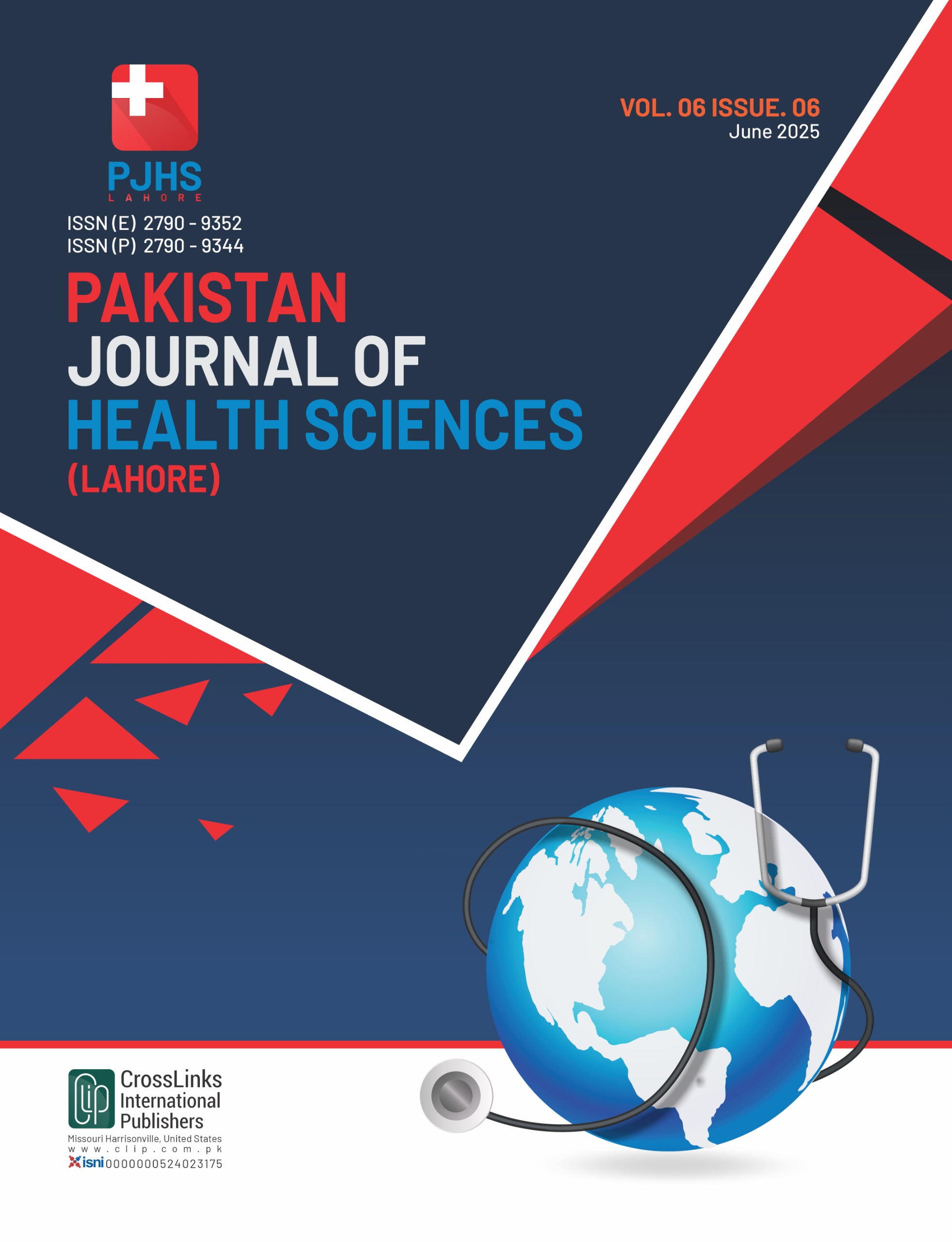Frequency of Types of Jejunoileal Atresia among Neonates Presenting With Intestinal Obstruction
Jejunoileal Atresia among Neonates
DOI:
https://doi.org/10.54393/pjhs.v6i6.3148Keywords:
Jejunoileal Atresia, Intestinal Obstruction, Congenital Anomalies, Type IIIa Atresia, Neonatal SurgeryAbstract
Jejunoileal Atresia (JIA) is a significant cause of neonatal intestinal obstruction, accounting for a substantial number of surgical emergencies in the first weeks of life. It results from congenital occlusion of the intestinal lumen, primarily due to intrauterine vascular accidents. Despite improvements in surgical techniques and neonatal care, early diagnosis and intervention remain critical for favorable outcomes. Objective: To determine the frequency of common types of jejunoileal atresia among neonates presenting with intestinal obstruction. Methods: This descriptive cross-sectional study was conducted at the Department of Paediatric Surgery, National Institute of Child Health (NICH), Karachi, from November 16, 2019, to May 15, 2020. A total of 97 neonates diagnosed with intestinal obstruction and meeting the inclusion criteria were enrolled. Detailed history, antenatal workup, and clinical examination were recorded. Diagnosis was confirmed intraoperatively, and types of JIA were documented. Results: The mean age at presentation was 5.78±4.24 days. Among the 97 neonates, 42 (43.3%) were male and 55 (56.7%) were female. The distribution of JIA types was as follows: Type I in 20 cases (20.6%), Type II in 11 cases (11.3%), Type IIIa in 45 cases (46.4%), Type IIIb in 10 cases (10.3%), and Type IV in 11 cases (11.3%). Conclusions: Type IIIa was identified as the most frequent type of jejunoileal atresia. Early recognition and surgical management are essential to reduce morbidity, mortality, and length of hospital stay in affected neonates.
References
Small Intestinal Atresia and Stenosis. Medscape; 2023 Sep 28 [cited at: 23rd April 2025]. Available at: https://emedicine.medscape.com/article/939258-overview.
Intestinal Obstruction in the Newborn. Medscape; [cited at: 23rd April 2025]. Available at: https://emedicine.medscape.com/article/2066380-overview.
Adams SD and Stanton MP. Malrotation and intestinal atresias. Early Human Development. 2014 Dec; 90(12): 921-5. doi: 10.1016/j.earlhumdev.2014.09.017. DOI: https://doi.org/10.1016/j.earlhumdev.2014.09.017
Garg V, Puri A, Sakhuja P. Novel insights into the histology of jejunoileal atresia and its therapeutic implications. Journal of Pediatric Surgery. 2020 Dec; 55(12): 2630-4. doi: 10.1016/j.jpedsurg.2020.05.006. DOI: https://doi.org/10.1016/j.jpedsurg.2020.05.006
Ludwig K, De Bartolo D, Salerno A, Ingravallo G, Cazzato G, Giacometti C et al. Congenital anomalies of the tubular gastrointestinal tract. Pathologica. 2022 Feb; 114(1): 40. doi: 10.32074/1591-951X-553. DOI: https://doi.org/10.32074/1591-951X-553
Schmedding A, Hutter M, Gfroerer S, Rolle U. Jejunoileal atresia: a national cohort study. Frontiers in Pediatrics. 2021 May; 9: 665022. doi: 10.3389/fped.2021.665022. DOI: https://doi.org/10.3389/fped.2021.665022
Munyalo FS. Determinants of Surgical Outcomes of Small Intestinal Atresia at Kenyatta National Hospital, kenya (Doctoral dissertation, UON).
Moore A and Kazmierski M. Bilious vomiting in a neonate. British Medical Journal. 2024 Oct; 387. doi: 10.1136/bmj-2024-079857. DOI: https://doi.org/10.1136/bmj-2024-079857
Rwomurushaka ES, Msuya D, Mbwambo R, Lodhia J. Type 3B jejunoileal atresia management at a tertiary hospital in northern Tanzania: A report of three cases. Clinical Case Reports. 2024 Jul; 12(7): e9170. doi: 10.1002/ccr3.9170. DOI: https://doi.org/10.1002/ccr3.9170
Virgone C, D'antonio F, Khalil A, Manzoli L, Giuliani S. Accuracy of prenatal ultrasound in detecting jejunal and ileal atresia: systematic review and meta‐analysis. Ultrasound in Obstetrics & Gynecology. 2015 May; 45(5): 523-9. doi: 10.1002/uog.14651. DOI: https://doi.org/10.1002/uog.14651
Okello I, Stephens CQ, Kakembo N, Kisa P, Nimanya S, Yap A et al. Efforts to improve outcomes among neonates with complex intestinal atresia: a single-center low-income country experience. Pediatric Surgery International. 2024 Mar; 40(1): 70. doi: 10.1007/s00383-024-05639-7. DOI: https://doi.org/10.1007/s00383-024-05639-7
Oh C. Jejunoileal atresia: a contemporary review. Advances in Pediatric Surgery. 2023 Dec; 29(2): 89-99. doi: 10.13029/aps.2023.29.2.89. DOI: https://doi.org/10.13029/aps.2023.29.2.89
Shakya VC, Agrawal CS, Shrestha P, Poudel P, Khaniya S, Adhikary S. Management of jejunoileal atresias: an experience at eastern Nepal. BioMed Central Surgery. 2010 Dec; 10: 1-6. doi: 10.1186/1471-2482-10-35. DOI: https://doi.org/10.1186/1471-2482-10-35
Burjonrappa S, Crete E, Bouchard S. Comparative outcomes in intestinal atresia: a clinical outcome and pathophysiology analysis. Pediatric Surgery International. 2011 Apr; 27: 437-42. doi: 10.1007/s00383-010-2729-8. DOI: https://doi.org/10.1007/s00383-010-2729-8
Tahkola E, Luoto T, Pakarinen MP. Management and outcomes of intestinal atresia-a single institution experience from 1947 to 2019. Journal of Pediatric Surgery. 2024 Nov; 59(11): 161622. doi: 10.1016/j.jpedsurg.2024.07.007. DOI: https://doi.org/10.1016/j.jpedsurg.2024.07.007
Lodhia J, Chipongo H, Mathew B, Msuya D, Chugulu S, Philemon R. Midgut atresia: diagnostic and management challenges from Northern Tanzania. Clinical Medicine Insights: Pediatrics. 2022 Dec; 16: 11795565221142810. doi: 10.1177/11795565221142810. DOI: https://doi.org/10.1177/11795565221142810
Verma A, Rattan KN, Yadav R. Neonatal intestinal obstruction: a 15 year experience in a tertiary care hospital. Journal of clinical and diagnostic research. 2016 Feb; 10(2): SC10. doi: 10.7860/JCDR/2016/17204.7268. DOI: https://doi.org/10.7860/JCDR/2016/17204.7268
Saraç M, Tartar T, Bakal Ü, Aydın M, Akdeniz İ, Kazez A. Intestinal Atresia: Twenty Years of Experience at a Reference Hospital. Istanbul Medical Journal. 2021 Feb; 22(1): 19-24. doi: 10.4274/imj.galenos.2020.98957. DOI: https://doi.org/10.4274/imj.galenos.2020.98957
Sholadoye TT, Mshelbwala PM, Ameh EA. Presentation and outcome of treatment of jejunoileal atresia in Nigeria. African Journal of Paediatric Surgery. 2018 Apr; 15(2): 84-7. doi: 10.4103/ajps.AJPS_120_16. DOI: https://doi.org/10.4103/ajps.AJPS_120_16
Tripathy PK and Jena PK. Demographic Pattern, Management, and Outcome of Intestinal Atresias among Neonates in a Tertiary Care Indian Hospital. Journal of Neonatology. 2021 Dec. doi: 10.1177/09732179211054084. DOI: https://doi.org/10.1177/09732179211054084
Downloads
Published
How to Cite
Issue
Section
License
Copyright (c) 2025 Pakistan Journal of Health Sciences

This work is licensed under a Creative Commons Attribution 4.0 International License.
This is an open-access journal and all the published articles / items are distributed under the terms of the Creative Commons Attribution License, which permits unrestricted use, distribution, and reproduction in any medium, provided the original author and source are credited. For comments













